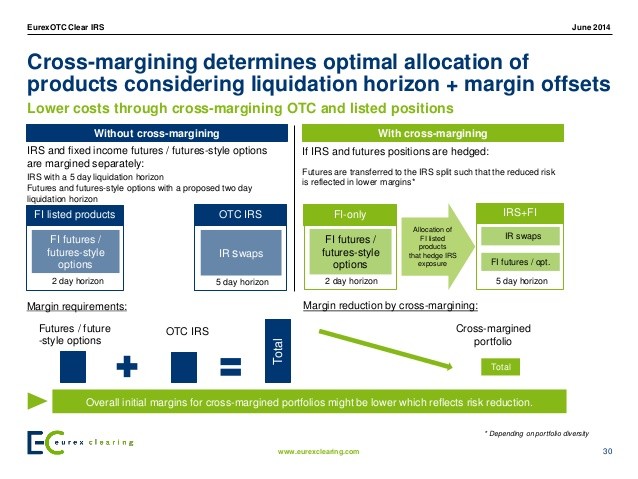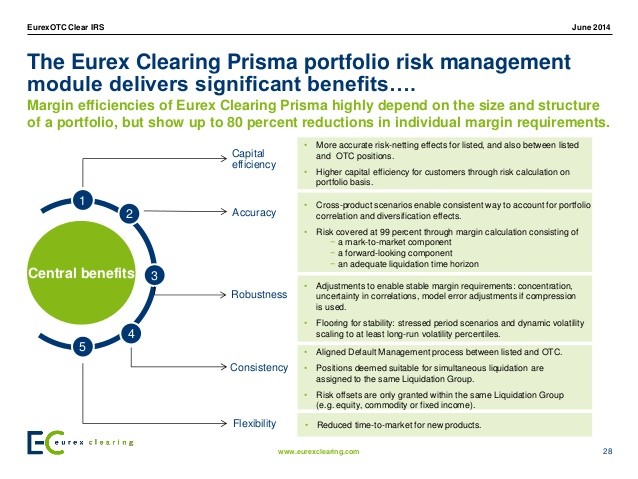Margin Efficiency at CCPs Portfolio Margining E
Post on: 6 Август, 2015 No Comment

May 20, 2013
Lynn Strongin Dodds weighs the pros and cons of interoperability between CCPs and explores how clearinghouses are looking to alleviate the margin burden as the industry moves to the mandated central clearing of OTC derivatives
Ever since the regulators threw down the collateral gauntlet, the race has been on to find the most efficient ways to reduce the new and more onerous margin requirements. Central clearing counterparties (CCPs) are at different stages of development but few expect them to join forces any time soon. Interoperability may sound like a good idea on paper but competition and not cooperation is currently on the agenda in the OTC world.
In fact, the landscape is getting more and not less crowded with the current tally in Europe and US reaching 15 including those such as ICE Clear Europe and ICE Trust which are separate entities owned by the same clearinghouse. This contradicts many academic studies such as the one conducted by Darrell Duffie and Haoxiang Zhu of Stanford University which shows that end users such as buy side clients would be better off if CCPs worked more closely together and allowed netting of collateral.
They argue that the benefits of central clearing are negated by multiple clearinghouses, especially when they each specialise in different asset classes which is mostly the path being followed today. Collateral efficiencies can only be gained through CCPs clearing across the investment spectrum. As the study points out, “Our results show that introducing a CCP for a particular set of derivatives reduces average counterparty exposure if and only if the number of clearing participants is sufficiently large relative to the exposure on derivatives that continue to be bilaterally netted.”
While the finding resonates with industry participants, all expect that the road to interoperability will be slow and winding. After all, it was not easy to achieve in the simpler world of cash equities and the OTC sphere is littered with many more technical and procedural hurdles. These include the different margin standards and default fund requirements used by individual clearinghouses which make it harder to calculate the exposures between two entities. In addition, there is a concern that clearing members and clients might be exposed to entities they may specifically have chosen to avoid, possibly due to concerns about risk management practices.
“Most clearinghouses are fairly inward looking and they need to put their own houses in order before they can interoperate with each other,” says Steve Grob. director of group strategy at trading technology provider Fidessa. “I do think there will be more focus on the ability to offer margin offsets between different but related instruments such as OTC and exchange-traded derivatives. It is a compelling proposition and will be one of the keys to winning market share.”
David Field. specialist in clearing and collateral management at consultancy Rule Financial. also does not see interoperability on the immediate or distant horizon. “CCPs’ agendas are too full and it is being kicked into the long grass. One problem is that clearing members who are siloed and have separate P&L’s for different products would have to make adaptations. They would have to create new internal structures and risk models that are cross siloed and share collateral pools. This creates operational challenges.
Another issue is from a risk management perspective. It would be difficult for CCPs to combine the two methodologies used — the conventional SPAN – Standard Portfolio Analysis of Risk — for futures and options, and historical value at risk (HVAR) models for OTC derivatives.”
SPAN which was developed by the Chicago Mercantile Exchange (CME), calculates the worst possible loss that a portfolio of contracts might suffer over a certain time period, typically one day. It achieves this by gauging the gains and losses incurred under different market conditions. By contrast, HVAR measures the potential loss in value of an individual asset or portfolio over a defined period for a given confidence interval. Using historical movements, the model calculates a forecasted volatility for each tenor using an exponentially weighted moving average methodology which applies heavier weights to the recent months of data in order to better capture current market conditions.
Many believe that SPAN is much better suited for standardised products with uniform amounts, expirations or options strikes while HVAR is more applicable to the more bespoke nature of OTC derivatives which have different tenors, coupons, strikes and types of interest rate assumptions.
“For portfolios that contain both listed and OTC contracts, you need to use the HVAR approach in order to compute offsets and deliver cross-netting benefits,” says Philp. “However, this also means that the listed products must be subject to the same five-day closeout period as the cleared OTC contracts, whereas on a standalone basis, a two-day closeout period for listed contracts is more common. The realised benefits of netting must exceed the additional margin requirement generated by the extension of the closeout period. CCPs that plan to clear both products that are eligible for cross-margining are confident though that significant benefits from netting can be achieved.”
For now though clearinghouses are forging ahead and rolling out new offerings with portfolio margining taking centre stage. This involves identifying instruments with price correlations with a firm’s cleared portfolio and offsetting those positions to reduce the overall risk profile. This often leads to less collateral having to be posted because some of the interest risk of a swap is countered by that of a futures position.

A Tabb Group report in 2012 estimated that “initial margin requirements for interest rate swaps will be lowered by at least 32% when portfolio margining becomes available to all market participants.”
CME Clearing, part of CME Group, was one of the first out of the gate with its portfolio margining swap product that covers Eurodollar and Treasury futures and cleared OTC interest rate products. “It had been in the works for some time,” says Dale Michaels. managing director for credit and market risk management at CME Group. “The savings can be substantial – up to 90% for a fully hedged portfolio. We have also integrated our CME Optimiser with CME CORE — Clearing Online Risk Engine which allows all market participants to automatically calculate their potential savings from the use of the portfolio margin programme.”
Eurex was also a first mover, launching EurexOTC, a new service that fully integrates the clearing and collateralisation of OTC and listed derivatives under one CCP roof. It incorporates Prisma, a portfolio margining system which operates across instruments. It looks at an entire portfolio of positions, rather than considering each one in isolation and then aggregating the results.
“Prisma is one of our milestones,” says Jens Quiram. head of clearing relations at Eurex Clearing. “We launched the service in the second quarter (2013) for listed equity and equity index derivative products and we plan to expand it to fixed-income futures and options in the fourth quarter this year. It offers a new portfolio-based approach to analysing risk and includes a number of components designed to enhance the modelling of risk, including adjustments for volatility dynamics, correlation breaks, and illiquidity.”
Meanwhile, rivals LCH.Clearnet, NYSE Euronext and the DTCC announced plans to offer portfolio margining across repo, cash and fixed income while the Intercontinental Exchange (ICE) has joined the fray for single-name and index-based credit default swap trades in ICE Credit Clear for house accounts, but not yet with their customers. This is because the Securities and Exchange Commission (SEC) has yet to approve portfolio margining for CDS contracts on individual companies.
Hand in hand with portfolio margining is the increasing list of collateral being accepted by CCPs. They have all proceeded with caution with cash and government securities but have slowly been opening the door to include other types of high quality and liquid securities. For example, Eurex’s eligible collateral cover 25,000 securities ranging from government, corporate and state agencies bonds to equities and cash (euro, Swiss franc, US dollar, sterling). “We have a robust valuation process,” says Quiram.” The collateral we use is of high standard and has dedicated haircuts.”
LCH. Clearnet has also widened its remit. We have been looking at our offering closely for the past 18 months in terms of how we can expand our range of eligible collateral whilst maintaining our high standards of risk management,” says Andrew Howat, head of collateral and liquidity management at the clearer, which last year widened its remit to Ginnie Mae mortgage-backed securities and gold. “The goal is to offer clients as much flexibility as possible to meet their margin requirements but we will remain conservative.”














